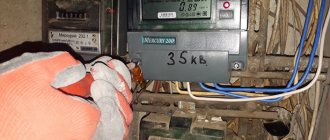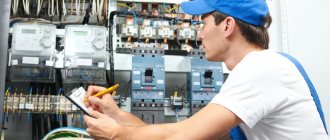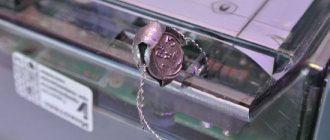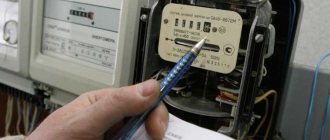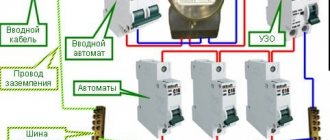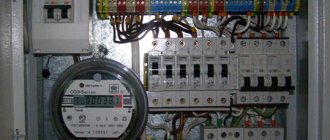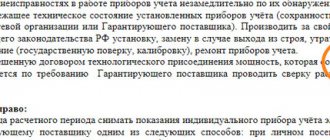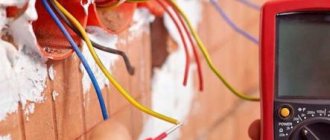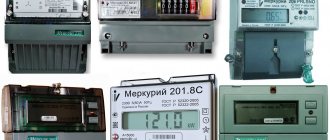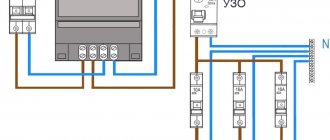The cost of electricity is constantly rising, and every time bills from energy sales companies arrive, despondency sets in. Consumers often wonder how they can legally save on electricity without paying huge sums of money. One solution to this issue is the installation of a two-tariff meter. But is this method of saving suitable for the average consumer? Is a two-tariff meter still beneficial or not?
What is a multi-tariff accounting system?
The amount of energy consumed depends on the time of day, which forces energy specialists to divide the day into several zones:
- NIGHT. Starts at 23.00 and ends at 7.00 am. Its peculiarity lies in the most favorable tariff.
- MORNING (PEAK). This zone starts at 7.00 and continues until 9.00. After rest, people wake up and get ready to go to work. They include many electrical appliances, which leads to a sharp increase in load. In addition, during this period the working day begins in companies and enterprises.
- DAY (HALF PEAK). This period covers a larger range from 10.00 am to 17.00 pm. The “lion’s” portion of people are at work, so the workload is approximately equalized. The largest consumption remains with companies, firms and organizations.
- EVENING (PEAK). In the period from 17.00 to 21.00, the second phase of the highest load takes place, when people return from work and turn on various sources of load, namely washing machines, electric kettles, air conditioners, PCs and other household appliances.
- EVENING (HALF PEAK). This zone is limited to two hours from 21.00 to 23.00. The period is characterized by a gradual decrease in load as people go to bed.
A multi-tariff meter is a special device for metering electricity that controls each of the mentioned periods. Thanks to this mode, the network is unloaded during peak hours due to the transfer of part of the power to the night or weekends.
The use of differential metering allows you to reduce costs, which is especially important for enterprises with a round-the-clock operating cycle or with short interruptions in the work of consumers.
Buying a multi-tariff meter is considered a profitable investment for manufacturers of various products. With this approach, it is possible to reduce the cost of goods and thereby increase profits.
To effectively use such devices, it is important to understand the intricacies of the operation of such meters and determine the relevance of their use.
As for apartments and houses, there are enough metering devices designed to work with two tariffs.
Why do you need an electric meter?
Electricity is not a free resource that every person needs in the modern world. Electricity consumption is strictly controlled by management companies. In case of prolonged non-payment, office representatives have the right to disconnect subscribers from the general network. Control is carried out using special devices.
The equipment is installed in every apartment, house, institution and production facilities. Due to significantly different energy consumption and differences in the design of engineering systems, manufacturers offer several types of electricity meters. This becomes the reason for the actualization of an important issue for the consumer: how to choose the right electric meter.
What is a two-tariff meter, how it works
The essence of a two-tariff meter is simple. Unlike a standard meter, it controls consumption in two zones - daytime (from 7.00 to 23.00) and night (from 23.00 to 7.00), which allows you to split the payment for electricity.
In the first case, the standard tariff applies, and at night it is significantly lower. If you plan to use powerful consumers at night, using a two-tariff meter is the way to save money.
The relevance of the transition to such devices is easy to explain. It is important for power plants and substations that the load on equipment is uniform throughout the day. In practice, it is higher in the morning, afternoon and evening hours than at night. As a result, equipment operates at its limit and breaks down faster.
The widespread use of two-tariff meters allows for load balancing, that is, transferring part of the load from peak hours to night time. As a result, fuel consumption is reduced and the service life of equipment at power plants increases.
Payback period for purchasing a new device
If you buy the cheapest device, for example, for 1450.00 rubles, then it will pay for itself in 6–7 months: 1450.00/239.00=6.07. When purchasing a more expensive device, for example, for 2660.00 rubles. — the payback period will be approximately one year: 2660.00/239.00=11.1.
If we include the cost of services for installing the device (on average 700 rubles), then the payback in the case of purchasing two meters of different prices will be:
- Let's calculate in the first case: (1450.00+700.00)/239.00=9;
- and in the second case: (2660.00+700.00)/239.00=14.
Even if you pay for the services of an installation specialist, the payback is quick and will be 9 and 14 months.
All calculations were carried out approximately, so each consumer must make an independent calculation based on his readings and the tariffs of energy sales companies.
Wave load
If we consider electricity consumption at the “lower level”, the graph looks like a sinusoid. For example, in a building with a large number of apartments, people rest at night, and a small part of electrical appliances (refrigerator, PC, night light and other devices) are in operation.
Between 7 and 10 a.m. the situation changes and the load curve rises sharply. People get out of bed and start getting their children ready for school, getting ready for work and solving other problems. As a result, many electrical appliances turn on, from the TV to the electric kettle and boiler.
Then the residents go to work, and the load situation returns to normal - the curve goes down again and remains there until the evening, when people return from work and start doing household chores - swimming, watching TV, heating food in the microwave, cooking in the oven, and so on Further. As a result, the current consumption increases again and reaches peak values.
The maximum load occurs until 10-11 pm, after which people gradually go to sleep, and the cycle repeats. It's time for another overnight low. To avoid the fluctuations discussed above, two-tariff meters are being introduced. Their feature is load control in only two zones, namely at night and during the day.
Reducing tariffs at night and increasing them during the day encourages people to switch to new metering devices. As a result, both sides win.
The consumer saves electricity and receives payments with smaller amounts, and the electricity supplier relieves substations and power plants, thereby extending the life of expensive equipment. The risk of network failures due to peak loads is also reduced.
A person who has installed a two-tariff meter can turn on the machine, boiler and boiler at night, when the electricity tariff is lower, and turn them off in the morning.
Typeit NEVA MT 124 AS OP 5(60) A
The single-phase multi-tariff meter NEVA MT 124 AS is intended for installation in residential buildings and apartments, as well as in offices. It can also work in tandem with external automated accounting systems (AIIS KUE). It has wide functionality and has class 1 accuracy. It can be configured for different tariffs by day of the week, time of day and even by season. It is possible to program up to 4 separate tariffs. The body of this model is non-separable. Operating temperature range from -40°C to +60°C.
Advantages:
- a large number of possible settings;
- equipped with an optical port.
Flaws:
- price.
Time of night and day tariff
We have already discussed this issue above, but we will cover it in more detail.
Fixing a price for a specific zone helps with the following tasks:
- Reducing load during peak hours;
- Reducing energy consumption;
- Protection of the home electrical network from damage or tripping of protective equipment.
Many people have been in a situation where, due to the inclusion of a large number of receivers in the electrical panel, the machine is knocked out. The reason is excessive load that exceeds the permissible level. For this reason, the input to the house or even the switch at the substation may be turned off.
The transition to a night tariff is relevant for rural residents, who will be able to turn on the heating of their home, greenhouse, and other premises only in the dark. As a result, heating costs are reduced by 30-40%, and sometimes more.
As noted, the two-tariff meter operates in two zones - from 23.00 to 7.00 (night) and from 7.00 to 23.00 (day). However, the night range may vary depending on the number of zones:
- Between 11 am and 7 am. With a two-zone tariff, electricity costs are reduced by 30% for ordinary consumers (individuals) and by 40% for companies (legal entities).
- Between 11 am and 6 am. If a three-tariff meter is used, the payment is even lower. In this case, the payment for night use is 35% of the regular rate (for ordinary citizens) and 40% for companies.
Video description
This video is about smart meters: what are they and should you be afraid of installing them:
See also: Catalog of companies that specialize in electrical work of any complexity
Electricians' note
It is worth noting the observations of specialists, which are based on the requirement to move meters in the private sector to the street. Based on Resolution No. 442, paragraph 138, the accuracy class should be at least second. Such a device can be used in conditions from -20 to +55 degrees Celsius with a humidity level of up to 80%. With other indicators, the error in the meter readings increases. Although the companies that control expenses claim that a coefficient has been introduced for calculating payments that takes this fact into account.
Installation of equipment on the street Source electro-znatok.ru
Current tariffs (using the example of Moscow and the Moscow region)
The amount of payment for electricity for two-tariff meters depends on three factors - the type of slabs in a multi-storey building, the time of day, month of the year, and the region. Let's look at the main options.
Multi-storey buildings with apartments with gas stoves
- In the period from January 1 to June 30, the night and day zone tariffs for Moscow are 1.79 and 6.19 rubles, and for New Moscow - 2.24 and 6.03 rubles, respectively.
- In the period from July 1 to the end of 2022, the following tariffs apply at night and daytime: 1.92 and 6.19 for Moscow and 2.41 and 6.19 for New Moscow.
Multi-storey buildings with electric stoves
- From January 1 to June 30, the night and day zone tariffs for Moscow are 1.26 and 4.65 rubles, and for New Moscow - 1.58 and 4.41 rubles, respectively.
- From July 1 until the end of 2022, the following tariffs apply at night and during the day: 1.35 and 4.95 rubles for Moscow and 1.7 and 4.74 rubles for New Moscow.
Apartments and houses located in rural areas
- From January 1 to June 30, the night and day zone tariffs are 1.58 and 4.22 rubles, respectively.
- From July 1 until the end of 2022, the following tariffs apply at night and during the day: 1.7 and 4.34 rubles.
Two-tariff electricity meter table
Full version of tariffs for 2022.
See all changes in tariffs for the next years on the website https://mosenergosbyt.info/tarify/.
INCOTEX Mercury 230 ART-01 CN 5(60) A
Multi-tariff metering meter, controls reactive and active parameters, power, measures other network parameters in 3-4 phase options. The accumulated information is sent for storage to data collection centers. The INCOTEX Mercury 230 model is installed strictly in enclosed spaces.
Accounting is carried out separately for all tariffs and amounts, which is very convenient. Energy values are available for the beginning and end of the previous day, readings reset, and other periods. You can create descriptions of tariffs. Each month of the year will be programmed on an individual schedule.
Advantages:
- detailed measurement of all characteristics of the electrical network;
- instant recording of values;
- long-term data storage;
- keeping a log of all events;
- adequate price;
- high reliability.
Flaws:
- It will take time to understand the functionality.
How do you pay?
To make a payment you will need a receipt with the accrued amount for the light, a calculator and a pen.
The algorithm of actions is as follows:
- We take readings from a two-tariff meter for the day and night shifts.
- We take the old receipt, according to which payment was made for the last month, and subtract the previous parameters in the section “On the day of payment” from the figure of the new readings. We multiply the resulting number by the tariff that is valid in the city (region) of residence.
- We subtract from the number of “night” readings the data that is recorded in the old receipt in the column “On the day of payment”. We multiply the resulting number by the tariff that applies to the night zone.
- Sum up the received figures for the day and night, after which we make a payment taking into account the result obtained at the nearest bank branch or in another way (for example, at a Russian Post office).
Video description
This video shows how readings are taken from the Mercury 200.02 model:
Based on user reviews, shortcomings in each meter were identified. Mercury does not have a display backlight and you have to select a large electrical box. Energomera's craftsmen note a weak point in the assembly. Owners write only about the advantages, including backlighting and the ability to take readings without voltage.
Three-tariff meter with display backlight Source alicdn.com
Advantages and disadvantages of two-tariff meters
When connecting a two-tariff meter, it is important to consider the pros and cons of such a transition. Let's take a closer look at them.
Advantages:
- For the consumer - a reduction in electricity costs by an average of 30-40%. This is due to the lower cost of electricity at night.
- For energy supply organizations - uniform distribution of load within 24 hours, which reduces overload during peak hours and helps to increase the service life of equipment.
- For the environment - reducing the volume of harmful emissions due to the uniform operation of the power plant.
- For enterprises, it saves energy at night, which helps reduce costs and production costs.
Flaws:
- Electrical appliances are left on at night, resulting in increased noise levels.
- Two-tariff meters are expensive and, according to users, often fail.
Energy meter CE 102 R5.1 145 J 5(60) A
Single-phase multi-tariff meter Energomera CE 102 with the possibility of installation on a DIN rail or in a panel. Provides the creation of accounting according to four tariffs and an additional one - emergency with the ability to broadcast the received information via optical channels and RS-485. The metering device displays the received information on the LCD display.
The meter is intended for use in residential and non-residential premises. The case is made of durable material, but does not have a high degree of protection - IP20 and is intended for closed, dry rooms.
Advantages:
- availability of standard and optical telemetry output;
- work indicator light;
- high measurement accuracy;
- A reverse stop is provided.
Flaws:
- high price.
When is installing a two-tariff meter beneficial?
To determine the relevance of installing a two-tariff meter, it is important to take into account a number of parameters - the presence of powerful equipment in the house or apartment, as well as the electricity tariff in the region.
To calculate efficiency, a number of steps are required. First, let's find out the price of 1 kW for a standard and two-tariff meter. After this, the amount of energy consumed at night is measured.
Once the declared parameters are in front of your eyes, you can substitute them into the following formula:
Mon = 100 x (Td - T1)/(Td - Tn), where:
- Mon—energy consumption at night;
- Тд — price of the daily tariff;
- Тн — cost of the night tariff;
- T1 – the price of a 24-hour tariff (on the meter this is a day zone, do not confuse it).
The final result is given as a percentage. For example, if it turns out to be 30%, this means that to get the effect you will have to increase the level of consumption at night by 30%. Only with this approach can we talk about the relevance of the new two-tariff meter.
If consumption at night is higher than the calculated parameter, this is only a plus.
Let's look at an example. We take the numbers from the photo below.
We get (6.19-5.38/6.19-1.92) x 100 = 18.9%.
Features when deciding to switch to a two-tariff electricity meter
Before installing a new meter, there are a number of factors to consider:
- tariffs for the supply of electrical energy and differentiation by zone in the regions of Russia vary;
- there is no guarantee that the cost difference between the “day” and “night” time zones will not change downwards;
- the electric meter must be installed by a specialist;
- consider payback;
- apply an individual approach;
- take into account the absence of gasification when making calculations.
It is impossible to answer the question which meter is better, single-tariff, two-tariff or three-tariff. Their differences lie in the accounting of electrical energy by time of day. Each case is considered individually, since the lifestyle and daily routine, the number of residents, the presence of household appliances with high energy consumption and other factors are taken into account. Each consumer can independently carry out a simple calculation, determine what is more profitable, decide to switch to multi-tariff electricity meters and install it.
How to choose a two-tariff meter?
Before purchasing a meter that records the amount of energy consumed in two different zones, it is important to study market offers and understand the nuances of such devices. Below are recommendations that will help you avoid making mistakes with your purchase.
What to look for when choosing?
Before buying a device, it is worth checking with your local energy supply organization about the possibility of installing such a meter and the availability of tariff divisions. It is important to remember that a multi-tariff device will cost more, so its installation should pay for itself. Otherwise, there is no point in installing the device.
It is also worth finding out the number of tariff levels, which can be 2 or more. A number of modern two-tariff meters have a large reserve and allow you to program up to eight or more modes.
Principle of operation
The electricity metering devices under consideration are divided into two types (according to the principle of operation):
- Electronic;
- Induction.
The latter are an outdated version of the device that was previously installed in all homes. The device consists of a coil that creates an EM field that rotates the disk.
Electronic devices are built on a semiconductor circuit that converts current into pulses. The latter are recorded by a counting device. Electronic metering devices are conventionally divided by the type of indication - it can be electromechanical or digital (the numbers are reflected on a special display).
It is logical to assume that multi-tariff devices can only be electronic and with digital display of indicators on a special screen. By the way, this feature makes a number of adjustments to the installation location. Such displays are afraid of direct sunlight and low temperatures. Under such conditions, the display may not display information at all.
That is why the device should be mounted in a special heated cabinet and away from sunlight.
Accuracy class
Based on this indicator, one can judge the maximum error of the device. This parameter is reflected as a percentage. If induction meters had a class of 2.5, new devices operating on a semiconductor base are more accurate - up to 0.5.
To find out this parameter, you should look at the technical documentation of the device or look at the device itself. The accuracy class is indicated as a number “hidden” in a circle.
The lower the number, the more accurate the device. When choosing, it is worth considering that for private houses an accuracy class of 2 and higher is allowed. As for class 1.0, it is mandatory for the input of buildings whose power is more than 0.67 MW.
In addition, according to the law, even with a low accuracy class, no one has the right to force the meter to be changed. This is done only at the end of the inter-inspection period or in the event of a product breakdown.
If employees of an electricity supply organization demand that the old device be replaced and a two-tariff meter with class 1.0 be installed, such actions are illegal.
Currents (single-phase, maximum, three-phase)
Most apartments in populated areas are connected to a single-phase 220V network with a frequency of 50 Hz. This means that when choosing a metering device, it is important to focus on this indicator.
But there are exceptions to this rule. In some houses where there are electric stoves, a three-phase network with a voltage of 380 Volts is supplied.
You can recognize a 3-phase network by the special type of plugs and sockets. Under such circumstances, you will have to buy an appropriate device connected to three phases.
Another important nuance is the maximum load current (maximum and minimum). Most devices are designed to carry a current of 60 A, which is enough for a house or apartment.
If calculations show that the total power of electrical consumers is more than 10 kW, it is recommended to take a meter with a maximum current of 100 A.
The peculiarity of such devices is that they are connected directly and without the use of additional converters. If the load exceeds 100 A, you will have to connect additional equipment (current transformer).
To find out the voltage and current parameters discussed above (min and max), just look at the technical data sheet of the device or look at the front panel.
What else to consider when choosing?
When studying the models available on the market, it is important to pay attention to additional functions. For example, many devices provide communication via GSM with the transfer of information to local stations.
In addition, devices are sold that control other types of resources, including gas and water.
Additional options also include:
- Entering electricity consumption parameters by month;
- Taking instantaneous parameters of current, power and other parameters and reflecting them in the log;
- Other functions.
INCOTEX Mercury 206 RN 5(60) A
The Mercury 206 meter maintains multi-tariff accounting, measures network parameters and stores the received information. Additionally, the device generates a line of events and provides information to the centers of automated accounting systems. The meter can only be installed in enclosed spaces (not outdoors); high air humidity is not permissible.
The energy is taken into account from the moment the readings are reset, for the last 180 days and 4 years for the last reporting period. The rater has the most detailed settings. The power profile averaging time is 30 minutes. Fixing of all parameters with transfer is available.
Advantages:
- the event log;
- convenient external power supply;
- wireless interfaces;
- presence of a pulse type output, built-in relay;
- precise filling;
- LCD indication when the network is disconnected.
Flaws:
- all the advantages are valid if the device body is properly fixed - invite a specialist.
Popular models
Today, three models of two-tariff meters are most in demand on the market - MZIP, Energomera and Mercury. Let's take a closer look at them.
Mercury
Mercury meters are produced by , which produces a wide range of metering devices - from conventional 1-phase devices to more complex 3-phase models.
The products are manufactured at a high technical and scientific level, which makes NPK Incotex one of the best companies today.
Now the company produces other products - cash registers, automated accounting and control systems, various types of screens and displays, POS and other equipment.
Popular multi-tariff meters include the following Mercury models:
- Three-phase - 256 ART, 234 ARM (2), 230 ART, 231 AT, 231 ART Sh.
- Single-phase - 206, 203.2T, 201.8 TLO, 200.
Official website of the company https://www.incotexcom.ru/.
Energy meter
The Energomera company positions itself as the Russian market leader in the production of metering devices. Every year, more than 3 million metering devices are produced at the enterprise's factories. Moreover, over 20 years of operation, more than 30 million devices have been produced.
The company includes 4 factories and 1 institute. In addition to two-tariff meters, the company produces ASKUE systems, low-voltage equipment, metrological and switchboard equipment, devices for electrochemical protection and other equipment.
Popular models of multi-tariff meters include:
- Single-phase - CE 102-R5.1, CE 102M-R5, CE 102-S7, CE 102M-S7, CE 201-S7.
- Three-phase - CE 307-R33, CE 301-R33, CE 307-S31, CE 303-R33, CE 303-S31.
Official website of the company https://www.energomera.ru/.
MZEP
At the moment, the Moscow MZEP plant is considered one of the best in the field of manufacturing metering devices. Every month, the plant produces more than 100,000 devices, which are used both in private homes and in large organizations.
The company's products are certified and meet internationally accepted quality standards. Before sale, the plant's two-tariff meters are tested by the metrological service, and their compliance with the requirements is confirmed by certificates.
Popular multi-tariff models of the manufacturer:
- Single-phase - AGAT 2-12, AGAT 2-23M, AGAT 2-23M1, AGAT 2-27M, AGAT 2-42.
- Three-phase - AGAT 3-1.100.2, AGAT 3-1.5.2, AGAT 3-1.50.2, AGAT 3-3.100.5, AGAT 3-3.60.2.
Official website of the company https://mzep.ru/.
Energy meter CE 301 R33 145-JAZ 5(60) A
The multifunctional three-phase meter Energomera CE 301 measures and records active energy in 3-4 wire circuits. The device can operate in a couple of directions at once; this is the organization of multi-tariff accounting. It involves storing and submitting accumulated information for its analysis, recording, and calculation of the cost of payments. A meter that transmits readings is more expensive than most meters, but is as convenient and functional as possible.
Installation is carried out in a din-rail and shield. Data is stored for 128 days, intervals for profiles can be configured. It is possible to manually adjust the clock rate up to 30 seconds per day; adjustments are made maximum once a day. The progress is accurate, calculated indicators are stored for 16 years or more, adjustments are also recorded. An external switching device is provided to control the loads.
Advantages:
- multifunctionality;
- saving a significant amount of data;
- load management by connecting an external switch;
- indication of data with their subsequent display on the LCD display;
- power supply from phases and line voltage;
- automatic calibration, accounting of all parameters.
Flaws:
- the price of the meter is above average.
Example of "savings"
To confirm the trick hidden in the day-night metering tariff system, we present the calculations of a user who decided to switch to an electronic multi-tariff meter. Not to mention its high cost (on average, the price of such a product is 2-2.5 times higher than that of a conventional device), after a thorough analysis, he discovered the following facts.
Electricity prices at the user’s place of residence are as follows: the daily tariff is 5.15, and the night tariff is 2.77. If you pay bills without taking into account tariffs, then this figure is 4.61.
Next, he gives a calculation of the monthly payment costs:
- Day: 80 kW x 5.15 = 412 rub.
- Night: 15 kW x 2.77 = 41.55 rub.
- The total for the month is 453.55 rubles.
Without taking into account the division into tariffs, it turns out: 95 kW x 4.61 = 437.95 rubles.
It turns out that when using a two-tariff meter, the owner of the apartment paid 15.6 rubles for the electricity consumed during the month. more. On the other hand, if you actively use electrical appliances at night, you can undoubtedly save money. But how many people want to wash, iron and cook food in the oven at night? Namely, the washing machine, iron and electric oven consume most of the total energy consumed.
